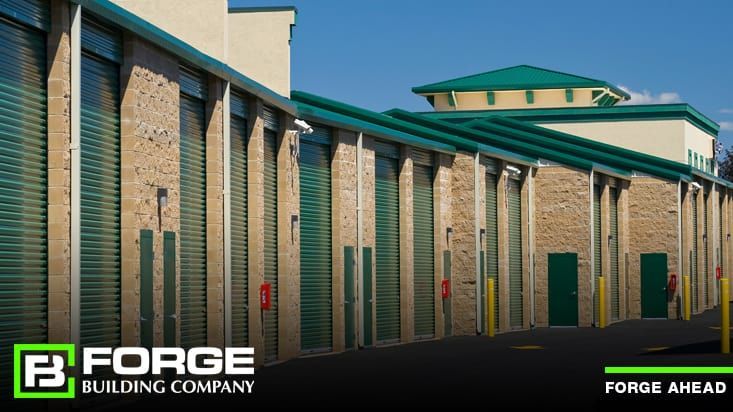
You have your storage facility up and running, or you’re in the planning phase of building your next facility... so what are the key factors you need to think about when it comes to your doors, roof, and climate control?
In our February 25th blog “Ensuring Form, Function and Long Life: How to Properly Care for Your Self Storage Unit Doors and Roof” we discuss how to properly care for your doors and roof. And in our November 21, 2021 blog post titled "Generate More Revenue by Offering Climate Controlled Self Storage” we discuss common uses and benefits along with design considerations when building a temperature or climate controlled self storage facility.
What it boils down to is that these three critical components are critical to keeping your facility and your tenant’s belongings safe, secure, and protected from any sort of criminal activity and/or weather elements. Using the right materials is also super important for curb appeal and energy efficiency.
One of the most distinguishing factors of a self storage facility are its steel roll up doors, so it’s important that they be well-maintained! Not only do they contribute to curb appeal, but they are a large part of the tenant experience providing safety for their belongings and can be a safety hazard if left untended. When building a new facility, metal wall and siding panel systems will provide the most flexibility when it comes to design, and these can be used for new construction or retrofit to existing buildings.
In addition, roll-up doors will also help maximize usable square footage in each storage unit.
Steel roll up doors should be inspected before a tenant moves in, and again after they’ve moved out. Inspection of a roll-up door doesn’t just mean ensuring it looks good, but also means it is functioning properly.
Here’s a closer look at metal panel wall systems.
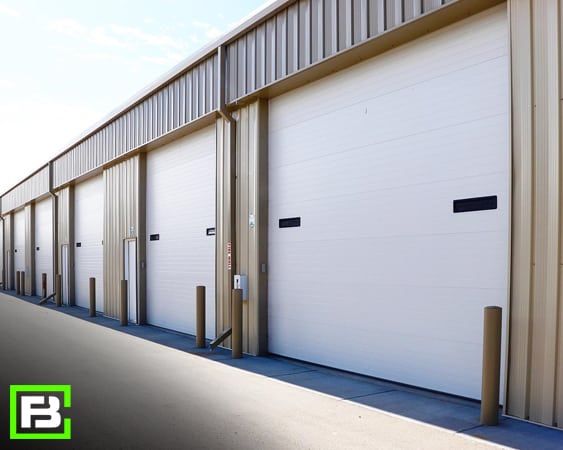
Metal Panel Wall Systems
There are a number of benefits to using metal panel wall systems for a self storage facility. First, they often come in a variety of colors that can coordinate with any buildings' décor to create continuity and increase the facility’s curb appeal. Metal panel wall systems are also durable, environmentally friendly, and cost-efficient.
In addition to the aesthetic appeal and safety ratings of metal wall panels, they are also revered for their sustainability in the building industry. Not only can they help with reducing the consumption of energy within the building, but they can also be recycled. Recyclable metals can then be restructured into other metal wall panels with the same structural integrity.1
The good news is that Forge has one of the largest selections of metal wall and siding panel systems in the self storage industry. The Company’s wall panels include single skin, insulated, exposed fastener, concealed fastener, and interior wall liners, and most can be installed both vertically and horizontally, providing additional flexibility in design. Forge’s metal siding panels can be used for new construction or to retrofit existing buildings.
In addition to providing complete building packages, Forge also offers components to be installed in buildings by our experienced team. The system can include either swing or steel roll up doors as well as man doors. Additional steel angle, wire mesh, and burglar bars are available as needed. Hallway walls can be purchased as flush or ribbed PBU panel.
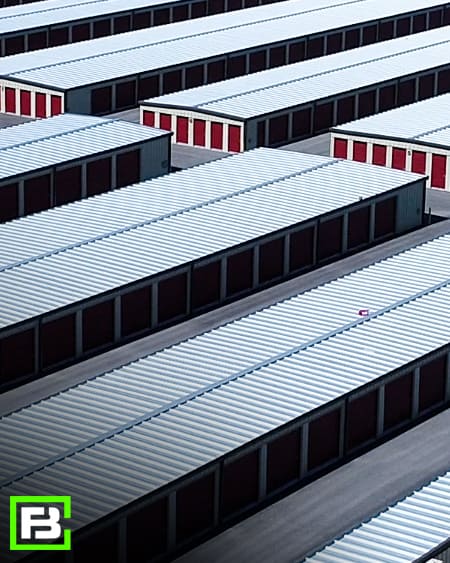 When looking at key factors for your existing or new facility, one of the biggest considerations is the roof. Protecting your tenant’s belongings is the main focus of a self storage facility. It doesn’t matter if you have a traditional, single-story facility or a multistory facility – your roof matters. Even a small leak can damage your customer’s property.
When looking at key factors for your existing or new facility, one of the biggest considerations is the roof. Protecting your tenant’s belongings is the main focus of a self storage facility. It doesn’t matter if you have a traditional, single-story facility or a multistory facility – your roof matters. Even a small leak can damage your customer’s property.
As self storage buildings age, roof maintenance and repair become more important and time-consuming. An inspection and maintenance program are an important part of sustaining roof life as well as keeping costly repairs and property claims in check. That’s one of the reasons the team at Forge Building Company recommends commercial metal roofs.
With proper inspection and maintenance, a metal roof can last for decades. The goals of a good inspection and maintenance program are to proactively locate and repair possible leaks while extending the life of the metal panels. This inspection and care will help you keep your roof in the best possible condition. The most effective examination for metal-roof systems includes four specific areas: the perimeter, the ridge, fasteners, and debris.
To learn more, see Metal Building Re-Roofing with Standing Seam Metal Roof Panels.
A metal roof will also act as a fire barrier if some part of the building or the surrounding area were to catch fire. Another benefit is that metal roofs can prevent water build-up from creating mold or decay problems that could destroy the building's structural integrity.
Very few places in the country are fortunate enough to avoid the frigid temperatures of winter every year or the extreme heat of summer. These extreme temperatures are not good for storing items unless you put them into a self storage unit that is climate controlled.
If your self storage facility is located in a part of the country that reaches temperatures above 90 degrees, air conditioning is definitely needed to protect customer’s property from problems like rotting or yellowing. Self storage units located in areas that fall below 32 degrees may need to be heated to prevent cracking or warping.2 And places with both extremes will need humidity protection. Fluctuating temperatures can create condensation inside electronics, causing irreparable damage. Likewise, anything that has liquid in it already can crack due to expansion from freezing. This is especially true of battery cells, including those for cars, mowers, and other small engines, which can crack when frozen.
A temperature-controlled self-storage facility is one that’s both heated and cooled. Its purpose is to provide an environment suitable for preserving stored goods, so the temperature range will typically be higher or lower than what you would find in a home or office—usually heated to 55 degrees and cooled to 85.
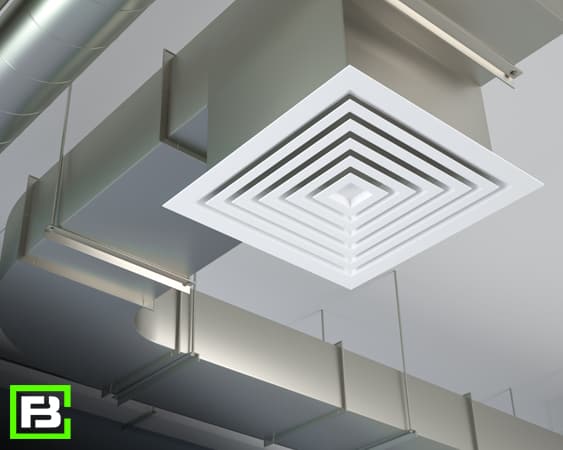
Today more self storage sites are starting to include climate control in the mix, and in some markets, many storage sites consist entirely of climate-controlled units. In most markets, climate or temperature-controlled units can be an excellent addition to your storage development. Through the use of insulation and central heating and air, a climate-controlled unit will protect your customer’s belongings in the harshest of winters and/or the hottest summers.
And with today’s more efficient building insulation, it’s more important than ever to work with a reputable storage unit contractor such as Forge Building Company to install a system that not only heats and cools, but also monitors and removes humidity.
Works Cited
1 Metal Sales. (n.d.). Retrieved from MetalSales.us.com: https://www.metalsales.us.com/metal-wall-panels/
2 StorageFront. (n.d.). Retrieved from storagefront.com: https://www.storagefront.com/storagetips/company-tips/climate-control/
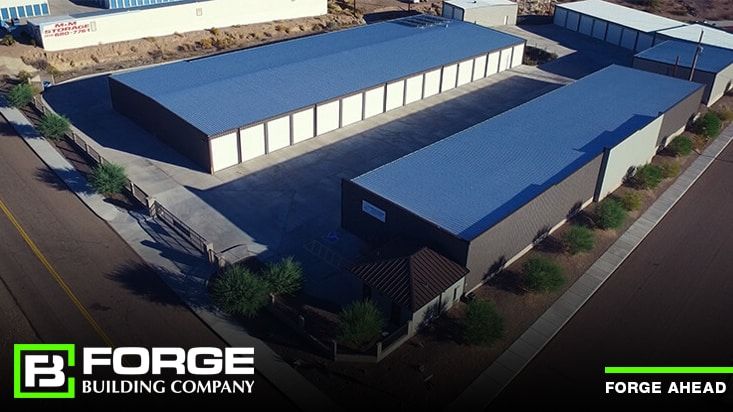
Boise, Idaho. – September 1, 2022 – Forge Building Company, a leading national building company with a strong focus on self-storage and innovative building solutions, today announced the groundbreaking on the second phase of its LuxeLocker Boat & RV Storage project, the premium luxury RV and boat storage facility in Boise. What is unique about this project is that customers own the individual storage units instead of renting them.
This project has included 107,023 square feet of facility. In the newest second phase, LuxeLocker is adding 63 new units. The facility is located at 7373 S Federal Way in Boise and will serve the areas dynamic and growing population and business community.
“We are proud that Forge Building Company was selected for this project because of the need for a premium facility that offers numerous amenities not typically found on storage properties,” said Hamish Bell, CEO of Forge. “We are confident that we can provide the specialized expertise needed for this kind of project given our experience with building many quality commercial RV and boat storage facilities.”
LuxeLocker is a premium property, offering larger units with widths of over 14’ wide and depths of 40’-60’. The average unit is approximately 700 square feet. Accompanying the generous unit sizes are expansive driveways wider than 60 feet. The facility is designed to accommodate large recreational vehicles for easy maneuvering. They also offer amenities for RV owners that most others don’t, including RV cleanout stations, RV wash bays, and bright night lighting.
The property is leading the industry by offering fully integrated of ‘smart’ technology. Customers can acquire space at a LuxeLocker and manage their property remotely from the comfort and convenience of their computer or smartphone—at home or on the road.
Forge Building Company and LuxeLocker plan on a high quality and aesthetically pleasing building using the latest in reliable construction techniques and innovations in the steel building industry.
Development that enhances the community makes for great neighbors, boosts property values, and supports smart growth. Forge Building will be constructing a lower height building that only rises to 18 to 22 feet around the perimeter. Noise and light pollution are practically non-existent. LuxeLocker’s premium clientele of owners, along with larger size units and fewer tenants per square foot, along with the recreational vehicle enhanced space reduces traffic in and out of the site for lower impact on the neighborhood.
LuxeLocker offers storage space that customers own instead of rent. The LuxeLocker model offers customers a long-term real estate investment, along with the ultimate in storage space. Purchasing a storage unit provides customers with an active asset with the ability for future capital growth. Space can be subleased to give owners a consistent passive income stream. Mortgage payments offer a tax benefit and are often lower than the rent on comparable units.
For more information, please visit https://luxelocker.com/.
Founded in 2007 and headquartered in Boise, Idaho, Forge Building Company was created after its founders, Hamish and Hayden, spent decades working in the steel-structure industry. Using their expertise in storage and focusing on the three pillars of buildings, designing, and erecting, led the company to a more diverse portfolio and stronger strategic partnerships across the U.S.
Today, the company offers steel buildings for self storage, RV & boat storage, car washes, airplane hangars, large warehouses, fish hatcheries, and craft breweries/restaurants. Other offerings include pre-engineered metal buildings for industrial and commercial applications.
With a strong portfolio of partners and clients, the Forge team has completed over 500+ jobs, built over 50 million square feet and remains privately owned. This solid team with complimentary skills was founded on a rugby field in New Zealand over two decades ago and is now working to be the best in the industry.
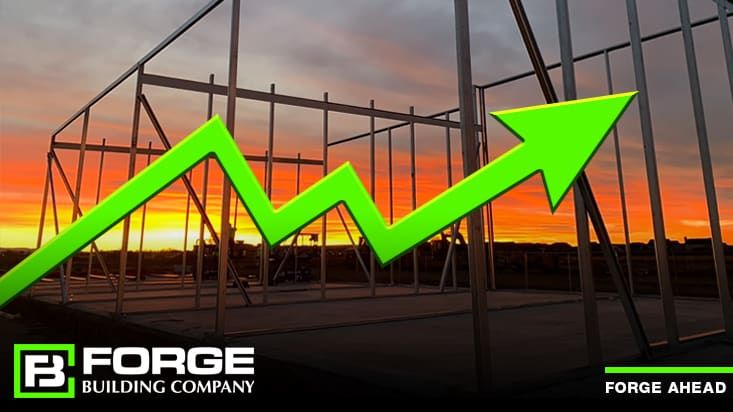
For more than 40 years, the Self Storage market has proven to be one of the sectors with the most rapid growth in the U.S commercial real estate industry. The unprecedented growth of the industry has been attributed to self-storage consumers including renters, homeowners, students, businesses, and transitional populations who are constantly demanding rental storage.1
The COVID-19 pandemic also led multiple business owners to opt for self-storage. Having to work from home for most parts of 2020 drove up the demand for self storage to cut out on rents on spaces. And to confirm this, the July 2022 National Self Storage Report by Yardi Matrix, indicated that demand continues to come from all directions, including the growth in home offices as most companies employ some type of hybrid strategy for knowledge workers, consumer spending on items such as clothing and furniture, and to a lesser degree businesses using storage for distribution purposes.
Solid occupancy enables property managers to push in-place rents, calculating that vacant units can be filled at higher rates. Concerns center around the slowing economy and rising interest rates that have produced a sudden chill on home sales, which produces an even greater demand for self storage.
In addition, there has been a trend of retailers using self storage as a warehouse and a high end bus company renting two buildings to store their buses-non conventional uses.
The global self storage market was valued at USD 48.02 billion in 2020 and is expected to reach a value of USD 64.71 billion by 2026, registering a CAGR of 5.45% over the forecast period, 2021-2026. The growth in this industry is expected to be positive during the forecast period, owing to the trends of increased urbanization and improved economic outlook across the regions.2
So, how do you know if a property is the right one to invest in for a self storage development?
 Market Analysis
Market AnalysisThe first step is to conduct a market analysis. A market analysis looks to see if there is demand in a particular area for self storage, how much of a demand there is, what specifically is there a demand for, and what the current rates are going for. This part of the process is NOT looking at whether the investment will be profitable, but more about what is current state of the market. Conducting a market analysis gives good foundational information that is included in a business plan. It also gives you information on who your customer is and what type of storage they want.
This critical first step can reduce risk, identify emerging trends, and help project revenue. You can use a market analysis at several stages of your business, and it can even be beneficial to conduct one every year to keep up to date with any major changes in the market.
One of the first things you will need to analyze is who your targeted customers will be. A target audience is a specific group of people who want and need what you offer. With self storage, your target market will likely be defined by demographics. Is your facility located in a college town where your most likely customers will be young college students looking to store items short-term for the summer? Is it near a military base where active duty military need to store items during deployment. Or is your target audience suburban homeowners looking for climate-controlled storage for their cars or other household items?
Understanding who you are marketing to helps you choose the delivery, location, and tone of your marketing programs. If you’re targeting recently divorced couples in your area or college students, you may want to emphasize competitive rates and easy renting processes. If you’re targeting businesses in need of files storage, you may want to focus on climate control and security at your facility.
Part of any self-storage market analysis involves deciding on your trade area radius, or how much of the area surrounding your business likely contains your target customers. You can look at current leads and tenants to see how close they live to their storage units. You can also use a general rule of thumb. In cities, self-storage customers may live less than one mile from their units (up to three miles). In rural spaces, your trade area radius may be up to 10 miles.3
Once you have a trade area radius, consider the demand for self storage units. You will want to determine demand by evaluating how many units are vacant and how many renters there are in your area. It can be challenging to determine vacancy rates of competitors, so you may need to evaluate the local population size and income levels as well to determine overall possible demand.
On a per-person basis, if the supply is less than the demand, the market is deemed to be under-supplied. If the supply is greater than the demand, the market is deemed to be over-supplied. As a test of reasonableness, a comparison of the conclusion to the average occupancy in the trade area can be made.4
Generally speaking, over-supplied markets have occupancy rates less than 80 percent and under-supplied markets have rates greater than 90 percent. A market with an average occupancy rate between 80 and 90 percent is deemed to be near equilibrium.
Understanding the supply and demand of the trade area is a key component to analyzing and forecasting rental rates
 Who Is Your Ideal Tenant?
Who Is Your Ideal Tenant?Once you have a general sense of the demand, supply, and trade area radius, you might want to consider tenants who may be under-served in your area. People who are moving are not the only ones who need storage units. Other possible leads include:
Once the market analysis is completed, the next and often simultaneous step is to do a feasibility study. A feasibility study can help determine the viability of a project or business venture by identifying the factors that can lead to its success. The study also shows the potential return on investment and any risks to the success of the venture.
A Market Feasibility Study determines the depth and condition of a particular market and its ability to support a particular development. The main objective of a market feasibility study is to understand the market to determine if enough demand exists to make the venture successful.
Conducting a feasibility study is always beneficial to the project as it gives you and other stakeholders a clear picture of the proposed project. It can also reveal many opportunities or pitfalls that may not have been apparent earlier. A feasibility study can help a self storage developer or owner understand the truth about a potential site, investment, and market. With this information in hand, you’ll be ready to plan and develop your project, mitigate known risks, or move on to the next opportunity.
A full Self Storage Feasibility Study also looks in depth at financial projections, marketing plans, unit mix, and many other factors.
The most important part of a feasibility study is the economics. Economics is the reason most projects are undertaken. This study should help you decide whether your self storage facility will produce enough revenue to generate a profit after taking care of debt and operating expenses.
Overall, this study will enable you to figure out who the customers within a one- to five-mile radius of the facility will be. Typically, a market for a self-storage facility encompasses a three- to five-mile radius, so your demand analysis should focus on this area.
Elements of a self storage feasibility study normally include business and demographic information such as:5
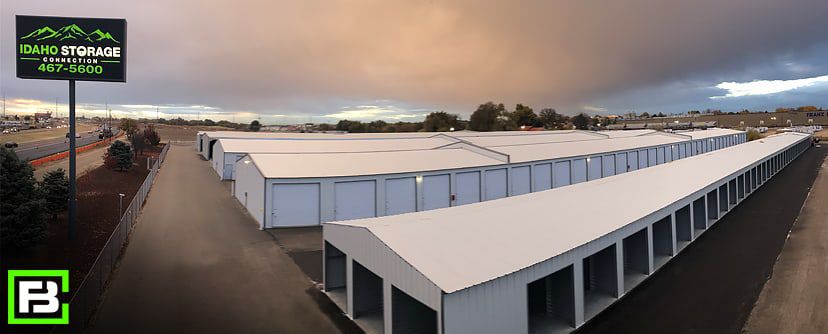
So, is spending the time and money to do a market analysis and feasibility study worth the investment? In our opinion, absolutely. A self storage analysis will help any owner or investor know what to expect in the future from existing or new projects. A self storage feasibility report is an important document that can help the stakeholders meet benchmarks and milestones as the project progresses.
A self storage market report can help an investor understand the local market and make an informed decision about buying or building. While a well-made self storage feasibility study will lay out the roadblocks to success and the likely paths to success, so investors can have a full picture of the range of outcomes.
Given this information, these two things are a definite necessity when determining whether or not to invest in the self storage industry, even if it means using a third party professional. A good Self Storage Advisor is totally worth the investment if they help you identify the best deals and steer you away from the ones to avoid.
Works Cited
1. InvestmentBank.com. (n.d.). Retrieved from Investment Bank: https://investmentbank.com/self-storage-real-estate-market/#:~:text=A%20sub-sector%20of%20the%20commercial%20real%20estate%20market%2C,growth%20in%20the%20U.S%20commercial%20real%20estate%20industry.
2. MordorIntelligence.com. (n.d.). Retrieved from Mordor Intellligence: https://www.mordorintelligence.com/industry-reports/self-storage-market
3. Scheib, K. (2021, 8 23). Investment Real Estate, LLC. Retrieved from irellc.com: https://irellc.com/resource/choosing-self-storage-target-market/
4. Spencer, K. (2019, May 2). Radius Plus. Retrieved from Radiusplus.com: https://www.radiusplus.com/post/how-to-conduct-a-self-storage-market-analysis/
5. Egan, J. (2021, August 23). Storable. Retrieved from Storable.com: https://www.storable.com/resources/learn/self-storage-feasibility-study/
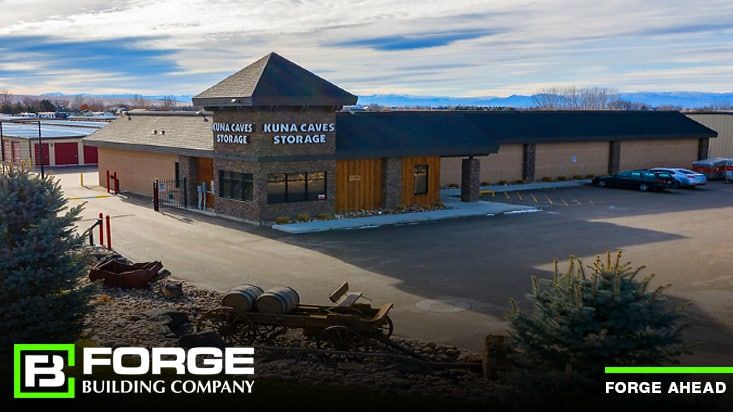
Construction costs, including those for self storage, are on the rise even though the amount of inflation fluctuate from location to location. If you’re planning to build or expand a self storage facility this year, it’s more important than ever to do your homework when it comes to research, design plans, and bids. (See our blog “A 10-Step Plan to Keep Your Next Self-Storage Development on Track.”
As the owner, it is key that you manage the day-to-day planning, coordination, and execution. It’s your vision, end stake, and money, so take the lead and educate yourself about the forces affecting the market.
In 2021, self storage facility construction spend in the United States dropped to $3.75 billion from its 2018 peak of $4.89 billion. This is a 19% 1-year decrease compared to 2020, a 926% 10-year increase, and a 294% 20-year increase. As the U.S. economy continues to grapple with the economic downturn caused by COVID-19, construction has slowed and will continue to be depressed in the short term despite increasing demand for self storage. (Neighbor.com, 2022)
Despite those statistics, the tremendous industry growth in this sector experienced over the last 25 years can be attributed to greater public awareness of the economic and personal advantages of this industry. Continued increase in demand, teamed with excellent investment potential, has made self storage one of the leading growth industries in the country since 1978 (The Parham Group, n.d.).
Given the current climate, below are some of the variables to be aware of, potential miscellaneous costs, bidding and contractual pitfalls, and other ways to mitigate overall development expenses.
 Within the last year the cost of single-story construction jumped from $65 to $85 per square foot. What this means is that with a $6 million, phase-one budget from the Small Business Administration, you’ll likely build closer to 40,000 square feet than 50,000 (Goodin, 2022).
Within the last year the cost of single-story construction jumped from $65 to $85 per square foot. What this means is that with a $6 million, phase-one budget from the Small Business Administration, you’ll likely build closer to 40,000 square feet than 50,000 (Goodin, 2022).
Annual price increases are very typical in the construction industry. COVID-19 over the last several years reduced steel manufacturing and stockpiling. Crippled supply chains have also caused prices to double. Today, however, steel production appears to be on the rebound, and demand will increase once the auto-chip deficit is over, and more cars and planes are built.
If you delay building or expanding your self storage property until prices stabilize, this could take months or years. The income benefit coupled with the growth and latest industry trends makes self storage definitely a great return on investment.
When you are considering building, construction cost is only part of your total development burden. There are many ways to reduce costs and avoid overruns when it comes to building your self storage property. The biggest way to avoid any pitfalls is to thoroughly review your potential self storage property in detail by use of a complete site plan. Look for:
It would be wise to leverage a civil engineer to review properties and local regulations to understand any potential extra costs that can be expected before you start your project.
To maximize your savings and optimize the cost of construction, it’s key to fully understand the expenses tied to certain building and site-design features that can lead to incremental extra dollars per square foot. Below are several other considerations that can impact your project costs. The team at Forge is here to help you make the best building determinations and evaluate your options based upon your budget.
Finally, pay attention to your roof. Many self-storage business owners make the common mistake of using screw-down roofing because it's generally more affordable. The team at Forge urges you to consider using standing seam roof panels instead because this installation doesn't require penetrating the roof with screws because of its joining rib design. The screws typically aren't a problem for the first year or so (depending on your environment), but those screws must be tightened or replaced over time. It's important to remember that each roof penetration increases the risk of leaks and ultimately disappointing your customers. Our services will help you retain your customers and protect their possessions. For more details, see Metal Building Re-Roofing with Standing Seam Metal Roof Panels.
Often times poor or incomplete bidding specifications can lead to higher construction costs. For this reason, every construction contract should include an addendum to list items that might otherwise be unaccounted for. These include:
 Full cleaning of walls and floors once construction is complete
Full cleaning of walls and floors once construction is completeAlso, if there are specific brand or quality requirements, these should be stated in the addendum with a note that no substitutions are permitted. A bid addendum helps guarantee that everything is communicated clearly to all parties involved.
Additional items you must account for in the total cost of self storage construction and financing include:
When bids are incomplete, this can lead to higher prices and unexpected cost overruns meaning you may then have to later downgrade a part of the construction.
Part of the project-planning process is to include a lease-up plan. The average self storage street rate for a 10x10 storage unit is $131/month, up 4% year-over-year.
The other good news is that the self storage industry has grown to more than 1.6 billion square feet of space so far in 2022 (StorageCafe.com, 2022). According to the latest Storage Café statistics, over the span of the last 5 years, 255.5 million square feet of storage space was built – that's equivalent to 16% of the total inventory. In 2021 alone, almost 44.3 million rentable square feet were finalized, an area that would cover either the whole of Central Park or the Grand Central Terminal. New supply in 2021 represents 3% of the existing inventory.
In even better news, a third of Americans planning a change of residence or needing more space at home reported that they use self storage. (Storage Cafe, 2022) A recent report from Storage Café found:
Self storage is relevant for both homeowners and renters who use it to better manage their belongings without cluttering their living space. In addition, with the COVID-19 pandemic, many customers started using self storage space for clearing space in their homes to work remotely.
These factors all result in greater facility value and the ability to recuperate project and construction expenditures more quickly. One of the other added benefits of commercial real estate is that it appreciates. Self storage owners also receive benefits from depreciation and amortization.
Your biggest expenses are in the land and building. Once you build, the cost doesn’t increase. Each year, you can typically raise rental rates to stay ahead of expenses and generate more profit. And, of course, when you sell, you’ll have an asset that’s worth more than when you built it due to inflation and the work you’ve put into increasing property value.
2021 was a record year for the number of self storage facilities sold. Higher occupancy and record rental rates have laid the groundwork for incredible increases in profit. This has also factored into newly constructed facilities still in lease-up being sold to buyers and providing multi-million-dollar returns for owners.
As you can see, there are a lot of factors that impact self storage construction costs. In the end, working with a company such as Forge to help put together a knowledgeable development team before you make an offer on land and properly executing each phase, from due diligence to bidding to design to operation, is necessary to keep everything on track and on budget. Give us a call! We’d love to help.
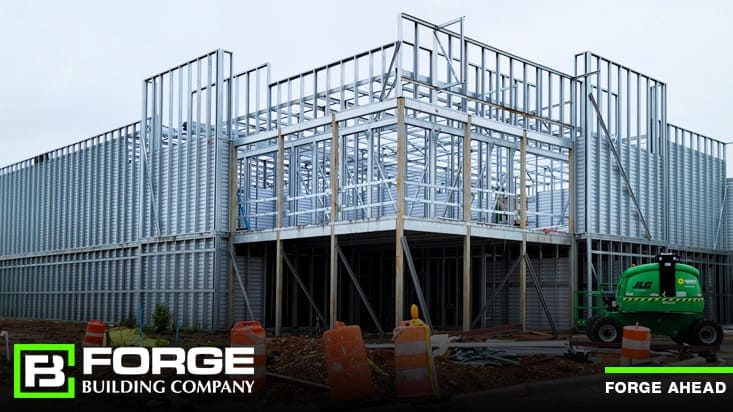
From Alaska to Florida, more than 50,000 self-storage facilities are scattered around the country. That’s about the same number of McDonald’s, Starbucks and Subway locations across the U.S. combined. These facilities are the foundation of the U.S. self-storage industry1, which was projected to generate $37 billion in revenue in 2019. The typical profit margin of a self storage business in the U.S. is 11%.2 That’s well above the profit margins for many other types of small businesses. Given those numbers, starting a self storage business, and keeping your self storage development on track is key. There’s a lot to do and many decisions to make.
Given today’s economy, it is key to act in a timely fashion. Developers and self storage business owners sometimes get stuck in the decision-making process, unable to move forward. No doubt, pursuing a self storage project can be overwhelming since there’s a lot to do and many choices to be made.
By being disciplined and taking one step at a time, you can make smart decisions. Here’s a ten-step plan to keep things moving forward in the right direction.
Before scouting locations for a self storage facility — no matter whether you’re looking at buying an existing facility or building a new one — you’ll need to look at the costs involved. The numbers will vary widely based on factors such as location, acquisition costs, land costs and construction costs. Things you will need to consider include:
Look at the cost of operation. A report released in early 2018 by commercial real estate company CBRE shows real estate taxes accounted for 28 percent of all self storage operating expenses, with on-site and off-site management costs eating up another 38 percent of operating expenses.
Develop a business plan. This can help propel the business toward success, letting you realize your goals and manage issues that might arise. In addition, most lenders will want to see a business plan before extending a loan.
Determine your scale of investment. You might be able to put up a single-story, 40,000-square-foot self storage development in a small town for $1 million or less, whereas a two-story, 80,000-square-foot facility in a more urban setting could set you back $6 million.
You can expect to spend anywhere from $25 to $75 per square foot on new construction. However, the location of the facility — including the cost of the land — will dictate the price tag for construction.
If you’re developing a self storage facility, consider:
Join networking groups and your local self storage association to help you learn from their experiences and gain referrals. Get to know professionals in the legal, real estate, financial, construction, and design industries that are experts in the self storage industry.
 Drive around in the areas that interest you. Look for high-density residential areas and known upcoming residential developments (single- or multi-family).
Drive around in the areas that interest you. Look for high-density residential areas and known upcoming residential developments (single- or multi-family).
Contact a commercial broker and/or your municipality. The city may be selling multiple parcels it owns. Based on its size, think critically about what type of facility could be built on the parcel.
Estimate whether it's good for self-storage. Call the municipality to find out how the land is zoned and any relevant regulations regarding industry development. If the property is already zoned for self storage, that removes a huge barrier. But if the property needs to be rezoned, you could spend months or years seeking approval for a zoning change.
Additionally, the issue of entitlement involves obtaining approval from government entities for your development plans. As with rezoning, an entitlement case could elapse valuable time.
Purchase the land with a 120-day due diligence period. The contract should state that your deposit is refundable during this period if you decide to forego the purchase. If you choose to buy the land, your deposit becomes non-refundable at 60 days. Also, give yourself 180 days to close.3
Complete a market feasibility study. This exercise will help you target the demographics of the customer base within a one- to five-mile radius of the facility. A three- to five-mile area is the typical size of a market for a self storage facility.
You’ll want to validate the median income in the market area (self storage renters tend to be in the middle-income and upper-middle-income brackets), along with the median age (self storage tenants are normally in their early 20s to mid-50s).
In addition, you’ll want to review the following aspects of your proposed market area4:
Other components of the feasibility study normally will include an overview of the self storage industry; long-range projections for rental rates, income, expenses, and property value; and details about the storage project’s zoning. This will help you determine whether the investment's land acquisition and building costs are sound.
This is also the time to look for any obstacles, such as easements, building restrictions, zoning and entitlement hurdles, water retention requirements, and wildlife, tree, or waterway conservation restrictions.
The study should also help determine your unit mix, what phases to build, and the amenities you should offer to achieve your desired return. It provides your operational budget, lease-up period, financial projections, and marketing plan and feeds into the basis of your business plan.
Determining how to finance an acquisition or a new development is your next step. Do you need to take out a loan? A number of options are available, such as acquisition loans, construction loans, and SBA loans. Many of these loans cover terms of 10 to 25 years. Work with a lending professional who’s well-versed in the self storage industry to point you in the right direction.
To qualify for a self storage loan, here are four things you’ll likely need:
Make sure you have enough liquid capital not only to buy or build a facility but also to operate the facility.
You may also want to consider strategically partnering with other investors to buy or build a facility. This can be done through:
If going the loan route, contacting multiple self-storage lenders and negotiating the best terms is best.
Be ready to send each lender or investor all the documents they need to make a quick decision. Your packet should include everything from your feasibility study as well as the items mentioned above, along with your business plan, tax returns, and personal financial statement.
If you ultimately choose a Small Business Administration loan, allow 90 days to close. If you’re going with conventional financing, allow 60 days.
At this stage, there are things you must do to prepare for building – obtain various reports and geographical surveys, such as a phase-one environmental site report, a soil-borings report, an engineer’s preliminary report, and an endangered-species report. Developing a self storage facility requires expertise so organizing your design team is crucial. The team at Forge can lead you through this process.5
A development team should include experienced legal, real estate, financial, construction and design professionals. Few people who are new to the self storage industry can solely develop a new facility.
The design process starts with a survey of the land. The architect creates a plot plan indicating the locations of buildings in relation to the land. In this initial design, the architect considers all the information the civil engineer has provided about site restrictions and the availability of utilities.
The next step is to design the floor plans followed by the elevations, or what the building will look like. Cross sections and details are added to indicate floor levels and details of footings, foundation, walls, floors, ceilings, and roof construction.
The structural engineer then assures the materials and how they are assembled are strong enough to withstand their weight, the weight of any use it may be put to, and all internal and external forces—known as vertical loads and lateral stresses—applied to the building.
A load is any force exerted upon a structure such as snow, wind, or earthquakes or the weight of the building itself. Live loads are produced by people, furnishings, equipment, and materials inside the building. Stresses are internal forces of a material constructed to resist external forces.
The civil engineering plan provides information about the excavation and grading needs the subcontractor will require to prepare the soil for foundations, ensure stormwater drains from the site, determine contours and elevations, and provide an earthwork estimate. That data will also help them provide an accurate bid for crew size, equipment, and timeline, and it’s needed by the retaining wall subcontractor and building manufacturer.
Forge Building Company has created its building design that allows for efficient use of materials and allows for crews to build quickly.
 Once the team has been assembled, the general contractor is responsible for making sure that everyone is building the project in accordance with the design. General contractors may provide labor and materials themselves, use subcontractors and vendors, or a combination of the above. Subcontractors provide their own shop drawings and may be in charge of trade-specific permits and inspections.
Once the team has been assembled, the general contractor is responsible for making sure that everyone is building the project in accordance with the design. General contractors may provide labor and materials themselves, use subcontractors and vendors, or a combination of the above. Subcontractors provide their own shop drawings and may be in charge of trade-specific permits and inspections.
The general contractor weaves everyone’s efforts into the completed product. Because of the volatility of material markets, most contractors won’t lock in pricing for materials and there could be price increases when material orders are processed. It is a good idea to ensure you include a Price Increase Contingency amount in your budget.
When you reach this step, the team at Forge is ready to assist. We will ensure your self storage project is built on schedule and on budget and will take pictures along the way.
With a project start date determined, your general contractor will give you expert feedback on construction activity and sequence of work to accomplish your goals best. Along this path, milestones will be identified such as:6
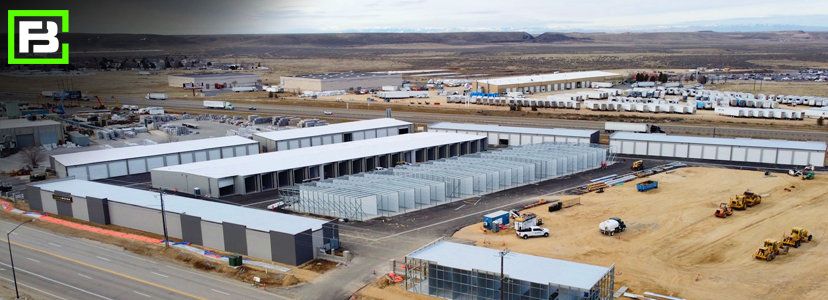
As the schedule is designed, the general contractor typically gets requirements from the major subcontractors to help determine realistic timelines. This information can also help identify long lead times for materials so they can be addressed early in the purchasing process and reviewed for the projected construction cash flow.
This is also a great time to set up your property-management systems and marketing initiatives to be ready to open as soon as you receive your Certificate of Occupancy. For technology considerations, see our blog “Technology – What You Need for Your Self Storage Business.”
Now is the time to leverage your marketing to lease the facility storage units. Your website is one of the biggest assets for a positive customer experience. It should be easy to find and use.
Content for your web presence is the single most important thing for search engine optimization and for prospects and customers to be able to find your business quickly. This includes your blog posts, social media, landing pages, FAQ pages, videos, and everything else related to your business.
Other helpful technology that will improve the customer experience includes any automation you use, security and access tools, digital signage, and property-management software that facilitates online rentals and autopay. Customers expect technology that’s easy to use, available around the clock, nice to look at, and engaging.
For more tips on creating the best customer experience, see our blog “Creating the Best Customer Experience for Your Self Storage Business.”
Once your self storage development is built, open, and renting, the most important aspects of hitting or exceeding your projections and maintaining high performance are answering your phone, monitoring rates regularly, keeping customers happy, and monitoring your marketing and online presence. In addition, it is key to think about giving back to your community, rewarding your employees, and starting to look for land for your next facility!
One of the best ways to create the ultimate customer experience is to walk through the process of renting a unit, visiting the site, and accessing the unit. Was anything surprising? Confusing? Alarming? Go about this drill as if you’re someone who knows nothing about the industry and see how easy it is to navigate the process of looking for, renting, and using self-storage.
The relationship you build with customers through these strategies and how you fulfill their needs is ultimately what will make their experience pleasant and help with retention and referrals in the future.
Works Cited
1 SpareFoot. (2021, January 27). Retrieved from SpareFoot StorageBeat: https://www.sparefoot.com/self-storage/news/1432-self-storage-industry-statistics/
2 Egan, J. (2021, September 13). Storable. Retrieved from Storable: https://www.storable.com/resources/learn/is-a-self-storage-business-profitable/
3 D’Agostino, K. (2021, October 5). InsideSelfStorage.com. Retrieved from Inside Self-Storage: https://www.insideselfstorage.com/development/9-step-plan-keep-your-next-self-storage-development-track
4 Egan, J. (2021, July 26). Storable. Retrieved from Storable: https://www.storable.com/resources/learn/starting-a-self-storage-business/
5 Inside Self Storage. (2008, September 15). Retrieved from InsideSelfStorage.com: https://www.insideselfstorage.com/construction/building-self-storage-creating-harmonious-design-team
6 Rogers, R. (2016, October 6). Inside Self Storage. Retrieved from InsideSelfStorage.com: https://www.insideselfstorage.com/construction/creating-and-managing-self-storage-construction-timeline
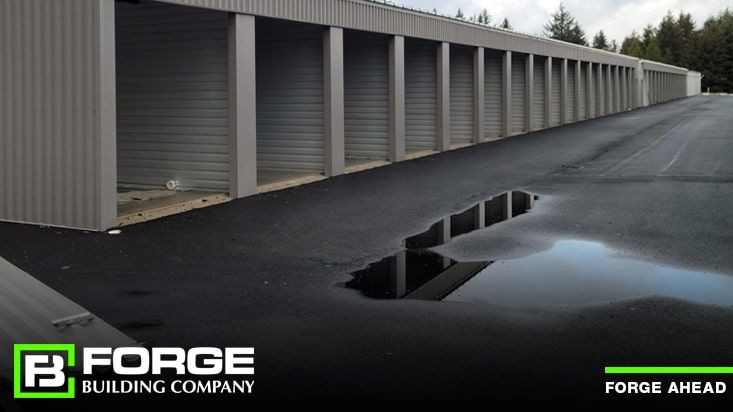
Disaster preparedness has never been more important than it is now. Natural disasters like hurricanes, tornadoes, flooding, or wind and hail can cripple your business. Even man-made events like arson, vandalism, burglary, or pollution exposure can be a significant disaster. Creating a disaster preparedness plan will save you time and money and can be the key to keeping your business going.
The best disaster plans start with a key list of emergency contacts including fire and police departments, insurance agent, electrician, plumber, and HVAC contractors. In addition, it is key to keep an updated list of tenants, employees, and vendors available including your steel building contractors. This information should be backed-up on a regular basis and retained off site. A site map or diagram, building plans, and bank account records should also be kept online and/or at an off-site location.
It is important to consider privacy implications when backing up tenant records. It is your responsibility to keep that information safe. If a data breach occurs, you have the duty to notify customers and comply with state and federal regulations. All facilities should consider a cyber liability insurance policy that includes legal services that can assist in determining regulatory obligations and notification requirements.1
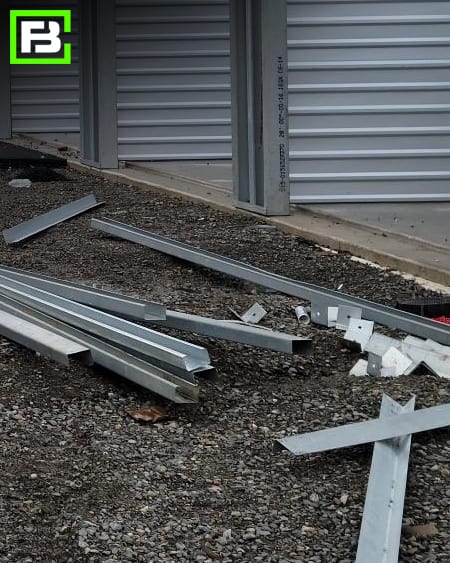 For the safety of your employees, your business should have an emergency kit on site that includes:2
For the safety of your employees, your business should have an emergency kit on site that includes:2
Your facility should have a plan in place for disruption in utility services. Ahead of time, determine what utilities are necessary for continuing your business and contact your local provider to see what back-up options are available for phone service.
To prevent arson, vandals, and burglaries, facilities should consider perimeter fencing at least 6 feet high as well as a surveillance system with a sign advising the facility is monitored. Central station burglar and fire alarms are always recommended, especially for the office.
Another step you can take is to contact your local disaster restoration company to see if they offer a preparedness assessment. Implementing what they suggest could minimize interruption to your business in the event of any sort of disaster.
Your facility’s emergency preparedness plan should be updated regularly. You can review and create your own plan at www.ready.gov.3 This plan should be shared with your insurance agent who will use this information to present your facility to underwriters for the most competitive insurance policy available. The more information you provide to your agent regarding disaster preparedness, safety features, and updates to plumbing, heating & electrical, and roofing, the better an underwriter can use this information to justify applying credits to your insurance premium.
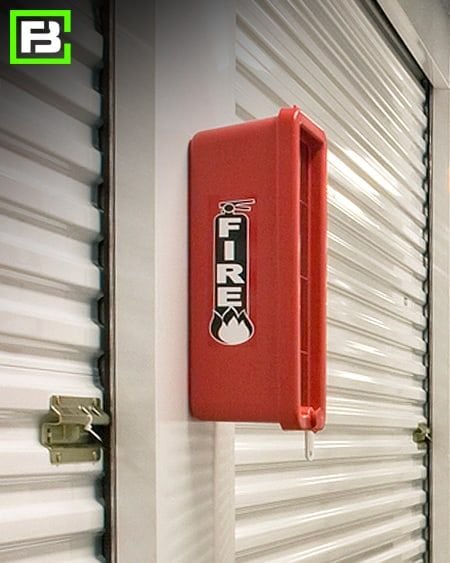
Firstly, tenant access to your facility should be restricted if an extreme weather situation is pending. Only emergency personnel should be allowed on site during a storm or disaster. Call the fire department immediately and evacuate the premises if there is a fire. All facility employees should be trained on the proper use of fire extinguishers. Employees must understand the safe use of fire extinguishers and be instructed never to try to fight a spreading fire.
When the facility is safe, the owner should do whatever is necessary to protect the buildings from further damage. Ensure the property is secure, contact local authorities, and then call your insurance agent to report the claim. Make sure to take photographs of all damage.
The next key item is when a situation occurs at your facility that results in damage to your tenants’ property, it is crucial that the tenants be notified immediately. Notice should be made both by phone and by written notice to each tenant's last known address. The notice should explain whether the tenant can recover its property from the facility and, if so, when. Access to a tenant's goods can usually be given unless the damage is so extensive that it would be dangerous for the tenant to enter the facility property. The written notice should also recommend that the tenant notify his or her insurance company.4
It is also extremely important to note that if a disaster cannot be controlled by the facility, most leases and rental agreements will protect the facility owner from tenant claims arising from the loss of their property. Self storage leases typically contain specific language stating that the facility will not be held responsible for the loss of or damage to its tenants' stored property from such natural occurrences or Acts of God. Self storage leases generally provide that the tenant's property is to be stored at their own risk and that the facility does not take care, custody or control of the property stored.
Self storage facility owners should be aware that standardized comprehensive and business liability policies will likely not cover tenant loss and damage claims and therefore they may need to add additional liability insurance for customer goods for added protection.
After a loss occurs, the facility owner must protect the property (and the contents) from further damage. All efforts should be made to cover or board up areas that remain open to the elements and rope off damaged areas to protect tenants' property.
Next, an incident report with photographs or video footage documents the loss and your efforts to mitigate further damages should be completed. Finally, it is key to contact your insurance company immediately. Many insurance companies will not be obligated to cover your claims if they are not given reasonable notice of the occurrence and have a chance to investigate it.
Even with the best planning, disasters can cause havoc for self storage facility owners. By implementing a “safety first” policy, a facility owner can often mitigate problems ahead of time. Once the dust has settled from the disaster and safety has been verified, the process can move forward with recovering the tenants' property and repairing the facility. As long as the proper insurance is in place, the financial impact of the disaster can hopefully be controlled.
Once the property is safe for access, facility owners should obtain dumpsters for their customers who have suffered a loss. Damaged property can be removed from the storage units (due to the certain risk of mold and mildew). Extra effort should be made to contact tenants who have not inspected their property within the first week since, after two or more weeks, the risk of mold and mildew on affected property increases. If the tenant doesn’t respond and before any action is taken to dispose of damaged property, the facility owner should again attempt to contact its tenant and work in concert with its insurance company regarding the need to clear the storage building of damaged property.
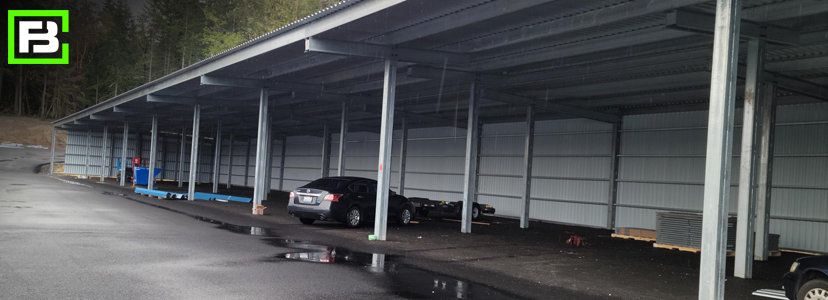
Additional emergency preparedness resources include:
CDC Emergency Preparedness
FEMA
Ready.gov
Red Cross
For assistance in weather proofing and securing your facility, give us a call. Team Forge is here to help ensure your facility is as safe and secure as possible. We will inspect and make sure your roof is secure as well as your hallways and doors. We look forward to helping you ensure you are prepared for any disaster.
Works Cited
1 Lamoureux, J. (2022, February 24). World Insurance. Retrieved from World Insurance
2 Silverado Self Storage. (n.d.). Retrieved from Silverado Self Storage
3 Ready. (n.d.). Retrieved from Ready: https://www.ready.gov/
4 Zucker, S. (n.d.). Self Storage Association. Retrieved from Selfstorage.org
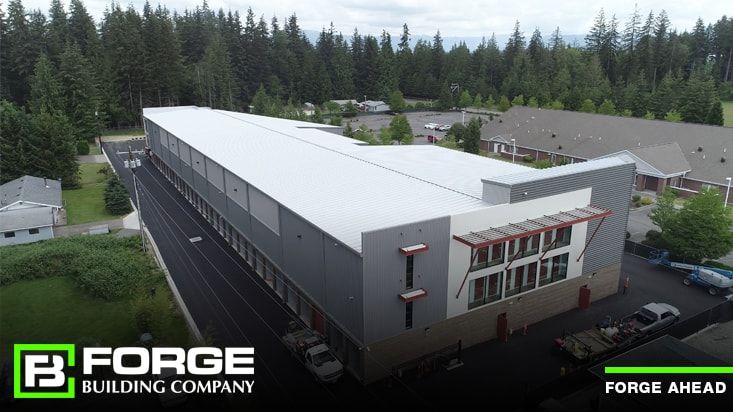
With climate change related to higher temperatures and drier weather conditions comes the threat of wildfire season. A wildfire can be devastating to a self storage business. An article from The Wall Street Journal indicates that wildfires could increase by up to 57% by the end of the century. (wsj.com, 2022) Following are conditions that set the stage for wildfires and in addition to corresponding tactics to improve your wildfire resilience.
Many self storage facility fires are caused by improperly stored flammable goods or packaging, however other fire risks include the following (Jensen, 2020):

There are a number of tactics for self storage facility owners. In California, most self storage facilities are Type II or Type III construction consisting of non-combustible concrete or masonry or light gauge steel. (Valli Architectural Articles, 2006)
Whether you’re in California or another state, all self storage facilities absolutely need a class-A and -B fire extinguisher as well as sprinklers. A sprinkler system is key for reducing fire, smoke, and water damage since it’ll use far less water than responding firefighters.
Here are some other simple tactics to protect your property from fire. It’s also key that staff members are trained and informed, safety equipment is available and in working order, and preplanned/drilled/validated protection routines and strategies are in place.
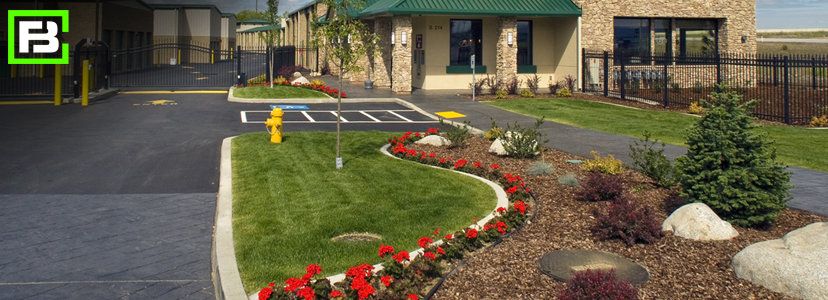
A lot of fireproofing hinges on staff and tenant education. Since many self-storage fires are caused by human error or arson, ensuring employees and tenants are aware of rules and responsibilities goes a long way toward increasing fire safety. Additionally, making sure your facility has the proper equipment, such as sprinklers, smoke detectors, and fire extinguishers along with firewise landscaping will increase preparedness and resiliency for the upcoming wildfire season. For assistance with upgrading or making your facility more firewise, give the experts at Forge a call!
Alalouff, R. (2022, February 28). IFSEC Global. Retrieved from ifsecglobal.com: https://www.ifsecglobal.com/fire-news/guide-fire-risk-assessment-get-one/
Jensen, O. (2020, September 1). Inside Self-Storage. Retrieved from Inside Self-Storage: https://www.insideselfstorage.com/disaster/tips-increase-fire-prevention-and-safety-your-self-storage-facility
Park, C. (2016, August 11). IFSEC Global. Retrieved from ifsecglobal.com: https://www.ifsecglobal.com/fire/a-guide-to-fire-alarm-system-types-2/
University of Florida Gardening Solutions. (n.d.). Retrieved from gardeningsolutions.ifas.ufl.edu: https://gardeningsolutions.ifas.ufl.edu/design/landscaping-for-specific-sites/firewise-landscaping.html
Valli Architectural Articles. (2006). Retrieved from Valliarch.com: http://www.valliarch.com/press-awards/articles/article06.pdf
wsj.com. (2022, February 23). Retrieved from The Wall Street Journal: https://www.wsj.com/articles/wildfires-will-become-more-intense-and-frequent-u-n-study-finds-11645652588
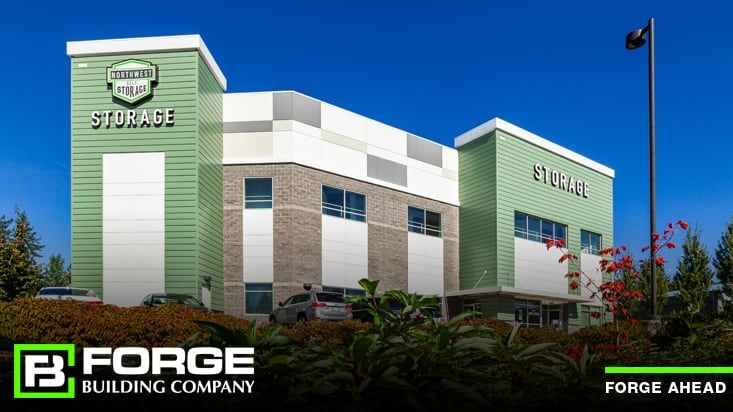
With so many self storage facilities popping up across the U.S., the thought of doing any sort of facility renovation causes many self storage owners and investors more anxiety versus excitement. Facility improvements offer many business advantages such as higher rental rates, increased property value, and happier customers that will stick with the facility once improvements have been implemented.
While the Self Storage industry is booming, there are a lot of properties out there that have aged with little or no maintenance, upgrades, or renovations to keep them operating at peak performance. This may include broken unit doors, leaky roofs and poor lighting or other safety hazards. When customers don’t feel that the items they are storing are being responsibly protected, they are more likely to seek out a facility that is newer, cleaner, safer, more sustainable or renovated.
All self storage facilities should have:
Forge Building Company can help you assess and improve your self storage facility to meet the needs of your customers while increasing rental income and property value. When determining what to renovate, Forge can evaluate your site, looking at the aesthetics and functionality to determine what areas should be upgraded or replaced – doors, hallways, roof, lighting, vehicle storage areas, and other equipment.
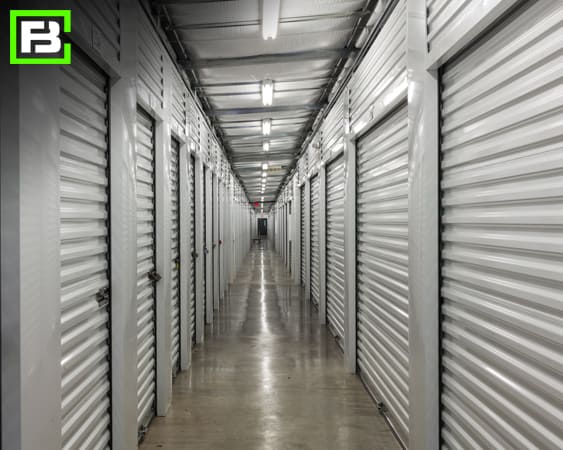 Many Forge customers are upgrading unit doors because their appearance and functionality impact site safety and security. Remember, curb appeal is the first thing a customer will notice. Also, replacing older doors can potentially lower your insurance liability and costs.
Many Forge customers are upgrading unit doors because their appearance and functionality impact site safety and security. Remember, curb appeal is the first thing a customer will notice. Also, replacing older doors can potentially lower your insurance liability and costs.
Replacement doors should be customizable, easy to operate and maintenance-free. This will result in minimal upkeep. Forge recommends dead-axle roll-up doors with factory-lubricated and enclosed springs that’ll be protected from harmful elements while ensuring smooth operation for many years. Samples can be seen here: storage building hallways and doors.
In a recent blog post titled Sustainability In The Self Storage Industry, Forge suggested several sustainability options, including:
Adding vehicle storage designed to house a car or other type of vehicle is another great upgrade. Think of it like a garage or parking space that you rent within a self-storage facility, with similar benefits depending on the storage company and unit that you choose, such as on-site security, gated access, and climate control.
There are four primary types of vehicle storage:
In a recent blog post titled Guidelines for Vehicle Storage, we discuss the various options for vehicle storage. One of the best ways to enhance your customer experience and grow your business is to offer RV and boat storage. Your customers will be motivated when they learn that they can store their RV or boat at the same storage facility as their other items.
Forge Building Company is a premier commercial storage builder that constructs not just self storage facilities, but also commercial RV and boat storage canopies. Because we partner closely with many self-storage business owners, we know what storage facilities require when it comes to their buildings and canopies. For samples of our vehicle storage projects, see Canopies RV Boat Commercial.
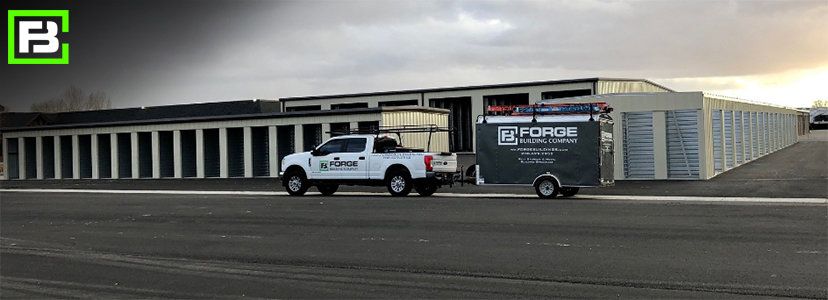
Many renovation projects can be completed without interrupting the rhythm of your business. The team at Forge can suggest a rollout plan to ensure your business continues to run smoothly during any renovations.
While the thought of renovation often brings concerns and questions over the financial burden, it is key to consider all of the benefits of the renovation. An improved facility will allow you to market all of the safety and sustainable new features to current and potential customers which will then allow you to charge higher rents, increasing your property value! It’s a win-win for both you, the property owner and your customers!
In addition, once the renovations are completed, there could be cost savings in utilities and insurance.
Cost seg (CSA, n.d.) is a tax-planning tool that allows you to write off discarded old materials as part of your federal tax filings.
Renovations aren’t just for older self storage facilities. They can benefit any site. If your occupancy rate is above 85%, consider upgrades. Making appropriate repairs and upgrades will provide your customers with a safe, secure and clean environment for their precious belongings enabling an easier justification for higher rental rates while increasing your property value.
Barnard, J. (2018, September 14). Retrieved from Inside Self-Storage: https://www.insideselfstorage.com/eco-friendly-storage/differentiation-through-sustainability-green-ideas-self-storage
CSA. (n.d.). Retrieved from CSA: https://www.costseganalysis.com/
U.S. Department of Labor. (n.d.). Retrieved from U.S. Department of Labor: https://www.dol.gov/general/topic/disability/ada
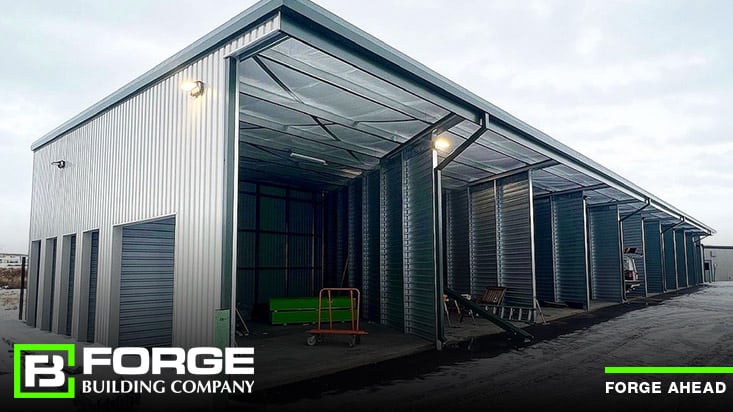
Most often, when you think of self-storage, you usually think of finding a place to keep boxes, furniture, and other standard household belongings. But what if what you need to store right now is a car or other vehicle? Vehicle storage works in pretty much the same way as regular storage, with various options available to help ensure that your vehicle stays protected when it’s not in use. Following is a quick guide to vehicle storage, including what you should do to prep so your car or vehicle is ready to drive off the lot later on.
Vehicle storage is a self-storage unit specifically designed to house a car or other type of vehicle. Think of it like a garage or parking space that you rent within a self-storage facility, with similar benefits depending on the storage company and unit that you choose, such as on-site security, gated access, and climate control.
There are four primary types of vehicle storage:
The various types of storage units for vehicles differ in terms of price and utility. It’s important to choose the type that’s best suited for your vehicle itself, particularly if it is highly valuable.
Each type of vehicle storage unit offers its own advantages and disadvantages. To figure out what unit will be best for you, you’ll need to consider not only availability (though that’s obviously a key factor) but what your specific vehicle requires.
This type of vehicle storage isn’t so much an individual unit as it is a parking space that you rent for a set duration. These are usually within a large parking lot on site of the storage facility, and the surface may be paved, grass, gravel, or dirt. This is the cheapest way to store a vehicle, and though you lack protection from the elements you still get the security benefits that come with renting at a storage facility. For added protection you can put a cover on your vehicle which will provide a barrier from the weather.
If you’d prefer to have your vehicle protected from things like sun, rain, and snow, then consider a covered parking space. These are generally housed in a large vehicle port shared by many vehicles, with open walls and a roof overhead. This type of storage doesn’t offer quite as much protection as an enclosed unit, but it’s better than the uncovered space if you’re worried about exposure.
These warehouses house multiple vehicles in a shared enclosure, with full protection from outdoor elements. They’re a cheaper alternative to renting your own enclosed unit since you’re sharing the space with others, but do not give you the ease of convenience when it comes to accessing your vehicle. These units may require you to schedule a time in advance to retrieve your vehicle.
The priciest option for vehicle storage is a non-shared enclosed unit, which is basically a garage that you rent just for your vehicle. You can drive your vehicle right in and out of these units so you don’t have to worry about access, and many self-storage facilities offer additional options such as climate control and live streaming to your unit so you can check on your vehicle as needed.
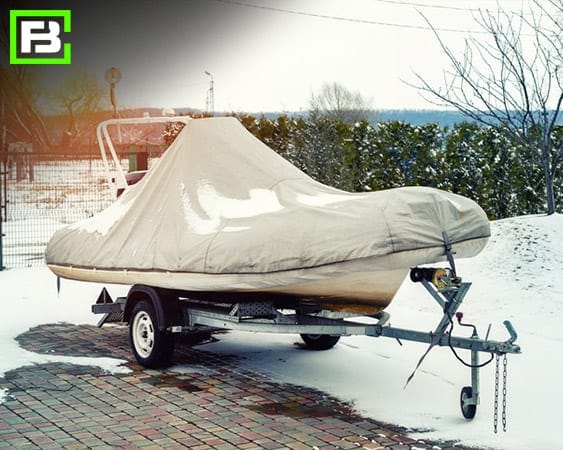 Most self-storage facilities also offer storage options for RVs, boats, and other large vehicles, including both enclosed and unenclosed units. Call your local storage facility to see what’s available. When Forge partners with storage companies, we put the customer at the front of everything. Luckily, you don't have to worry about the durability of our canopies. As commercial storage builders, we work with only top-quality materials to guarantee our customers the best possible canopy. It's not your responsibility to check the quality of the canopies; we take care of that for you. Here’s an example of what to look for: Commercial canopies for RV and Boat storage.
Most self-storage facilities also offer storage options for RVs, boats, and other large vehicles, including both enclosed and unenclosed units. Call your local storage facility to see what’s available. When Forge partners with storage companies, we put the customer at the front of everything. Luckily, you don't have to worry about the durability of our canopies. As commercial storage builders, we work with only top-quality materials to guarantee our customers the best possible canopy. It's not your responsibility to check the quality of the canopies; we take care of that for you. Here’s an example of what to look for: Commercial canopies for RV and Boat storage.
The average cost to store a vehicle or RV varies from about $45 a month to $450 a month depending on the type of vehicle storage unit you rent and the size of the unit that you require. Tack on an additional $50 a month or so if you are going to be renting a climate-controlled unit.
When it comes to vehicle storage costs, size does matter. A storage space that’s too small will be difficult to navigate, if not impossible to use altogether. A storage space that’s too big will run you a higher rate than you need to pay. If you’re like most vehicle owners, you probably don’t know the dimensions of your vehicle off the top of your head. You probably also don’t have a laser-calibrated vision of what 10 feet looks like compared to, say, 8 feet or 15 feet. Stor-It Self Storage provides the following guideline that outlines storage space size for your vehicle.
A 10 x 15 storage space is good for compact vehicles, such as:
A 10 x 20 storage space is ideal for storing several commonly used vehicles, such as:
A 10 x 25 storage space is good for most bigger vehicles, such as:
Vehicle storage is a safe way to store your vehicle until you need it again. That being said, there are some steps that you’ll want to take prior to putting your vehicle into storage so that you can be assured that when you’re ready to drive it off the lot it will be good to go—especially if you plan to store your vehicle for at least a year. Edmunds suggests some of the following ideas.
It’s a good idea to get some basic maintenance performed on your vehicle if you’re going to be leaving it in storage for a while. This should include having someone check your coolant levels and tire pressure and may also require a change of your oil and filter. Let your maintenance provider know that the vehicle will be going into storage, and they should be able to assist you on the best next steps.
This step may seem a bit strange. Why would you clean your vehicle if you’re just going to store it? The reason for this is that any dust, dirt, or residue that is caked on top of your vehicle when you put it into storage will wear down the paint and metal of your vehicle’s exterior. Don’t let that happen. Do the same for the interior, too. Be sure to remove any food that’s in your vehicle too, since even if it’s non-perishable and not at risk of going bad it could be a draw for rodents.
 A battery maintainer, also called a float charger, will help keep your vehicle’s battery from dying while in storage. It works by continually monitoring the battery level and periodically sending a surge of power as needed to ensure that the battery stays full. Unlike a basic battery charger, a float charger stops supplying power once the battery is at capacity, so you won’t have to worry about overcharging—nor will you have to worry about needing to jump your vehicle when you’re ready to use it again.
A battery maintainer, also called a float charger, will help keep your vehicle’s battery from dying while in storage. It works by continually monitoring the battery level and periodically sending a surge of power as needed to ensure that the battery stays full. Unlike a basic battery charger, a float charger stops supplying power once the battery is at capacity, so you won’t have to worry about overcharging—nor will you have to worry about needing to jump your vehicle when you’re ready to use it again.
Worse things can happen than a stuffy vehicle, but if you’re going to be using an enclosed unit then crack your windows slightly to facilitate air flow and keep the interior from getting musty.
To keep your vehicle clean no matter how long it’s in storage, invest in a quality vehicle cover.
You may have been taught to engage the parking brake every time you park your vehicle, but you should do the exact opposite when storing your vehicle for long periods of time. If you do use your parking brake during storage, you run the risk of damaging your brake pads and rotors. If brake pads and rotors are in contact for long periods of time, they may fuse together. This can lead to major headaches on your end, major safety issues when it’s time to drive your vehicle again, and major funds getting flushed down the drain to fix your rotors and brake pads. To keep your vehicle stable in storage, use tire stoppers. They’re much better for your vehicle.
There’s nothing worse than making the decision to sell your vehicle and realizing that you can’t legally sell it because you don’t have your title. Keep your title in a safe place where it won’t get stolen, lost, or forgotten. Also, be sure to keep your vehicle registered while it’s in storage. Even if you are thinking about trying to unregister your vehicle (because you’re not exactly using it), you will not legally be able to do so. In order to store a vehicle in a storage unit, you must have the vehicle registered under your name.
You don’t need to drive your vehicle, but you do need to start it up every so often to ensure the battery stays in good shape. When you do start your vehicle, you shouldn’t leave it idling in the storage unit, as this can lead to a life-threatening buildup of carbon monoxide. If you don’t want to drive your vehicle, at least roll it outside of the unit and leave it on for a few minutes to recharge the battery. There’s nothing worse than finally getting ready to take your vehicle out of storage and not being able to start it because your battery is dead.
To find exactly what you need for your vehicle, call a few different storage facilities to see what they offer in terms of units, features, and pricing.
Storing your vehicle in a storage unit or parking space is a unique endeavor that requires preparation. Whether you’ve had a storage unit for a while, you just got your very first-ever storage unit, or if you are on the fence about wanting to get a storage unit in the first place, you’re going to want to do your homework. As a premier commercial storage builder, Forge has built quality canopies and storage units that will protect your investment. Are you a storage company looking to add or upgrade your vehicle storage? Give us a call today to help.